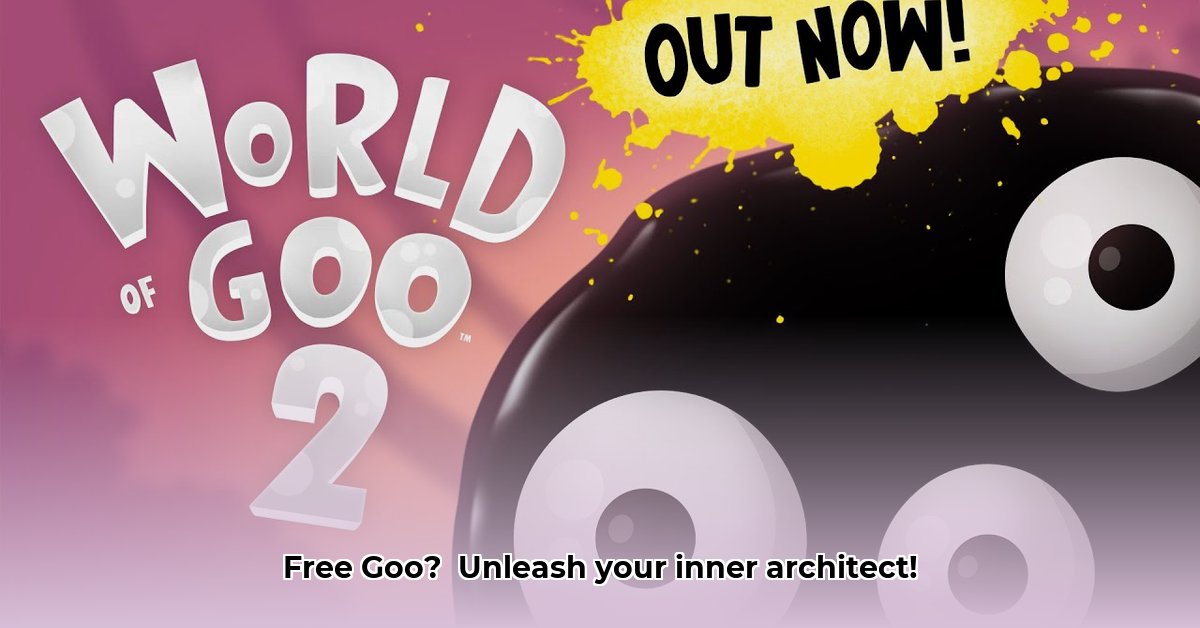
A Sticky Situation: Why World of Goo Free Still Reigns Supreme
Remember that first time you wrestled with those adorable, yet slightly unsettling, goo balls? World of Goo Free isn't just a game; it's an experience. Deceptively simple yet endlessly challenging, it’s a masterclass in puzzle design that keeps pulling you back in. Ever wonder how a tiny indie game achieved such massive, lasting success? Let's dive into the gooey goodness. Isn't it fascinating how a game with such seemingly simple mechanics has captivated players for so long? The answer lies in its innovative design and enduring charm.
Gooey Goodness: Gameplay That's Both Simple and Surprisingly Deep
The core gameplay is brilliantly simple: connect goo balls to reach a pipe. But don't let that fool you. This basic idea explodes into a fantastically complex and inventive puzzle experience. Each level throws new goo ball types at you—each with unique traits and quirks—demanding clever and creative problem-solving. It's a perfect example of emergent gameplay – simple rules leading to infinitely varied and challenging situations. The game's unconventional approach, rejecting traditional game design with no hand-holding, makes success all the more rewarding. This isn't just about problem-solving; it’s about the joy of discovery.
This unconventional approach wasn't just a cool stylistic choice—it was a necessity born from the realities of indie game development. Limited resources often mean thinking outside the box, and World of Goo Free proves that constraint can be the mother of invention. It’s a testament to resourcefulness leading to a unique and extremely memorable gameplay experience.
The Enduring Charm: Why it Still Matters Today
Years later, World of Goo Free remains remarkably fresh and relevant. Its HD remaster wasn't just a visual polish; it was a vital update that made this classic accessible to a whole new generation of gamers, while still retaining its charmingly retro feel. Nostalgia plays a part, of course, but the core gameplay loop remains astonishingly addictive. The game expertly ramps up the challenge and complexity without ever losing its signature style. It's a true testament to its enduring quality.
The passionate, active modding community also plays a huge role in its ongoing success. Players are constantly creating and sharing new levels, challenges, and even whole new game modes. This community-driven expansion shows just how engaging the core game is—it's not just a game, it's a platform for creativity that keeps on giving. How many games can boast such a dedicated and creative community years after release?
The Gooey Truth: Challenges Faced and Future Potential
While World of Goo Free enjoyed immense success, it hasn't been without its share of challenges. The lack of a direct sequel has been a topic of much discussion among fans. While there's been talk of a sequel, Tomorrow Corporation, the developer, chose to pursue other exciting projects. This raises a really important issue for many smaller indie developers: how do you strike a balance between market demands and artistic freedom? The decision highlights the complexities of indie game development and the choices developers face in balancing creative vision with commercial success.
Lessons Learned and Future Possibilities
World of Goo Free is a fantastic case study for indie game developers. It shows the power of innovative gameplay, a strong artistic vision, and the importance of a passionate player community. This game beautifully illustrates how simple yet deep gameplay can create a lasting masterpiece. The recent remaster also emphasizes the importance of keeping your game accessible and constantly supported. The future of this game—and similar indie titles—likely depends on thoughtful development choices, including smart iterative improvements, better collaboration with modders, and perhaps, just maybe, that elusive sequel one day.
How to Create Unique Game Mechanics Like World of Goo
Key Takeaways:
- World of Goo's enduring appeal stems from its innovative physics-based puzzle mechanics and charming art style.
- The game's modding scene, though small, presents a significant opportunity for creative expansion.
- Understanding the core mechanics of World of Goo—simple yet deeply engaging—is crucial for aspiring game designers.
Decoding World of Goo's Genius: Simple Physics, Endless Possibilities
World of Goo isn't just a puzzle game; it's a testament to elegant game design. Its success boils down to deceptively simple mechanics that unlock surprisingly complex gameplay. How did they do it? Let's dissect the core elements:
- Intuitive Controls: The fundamental interaction—placing goo balls—is instantly understandable. The learning curve is gentle.
- Emergent Gameplay: The seemingly simple act of connecting goo balls generates unexpected consequences and playful experimentation.
- Progressive Difficulty: The challenges gradually increase in complexity. Early levels teach the basics; later levels demand creative problem-solving.
- Charming Aesthetics: The game's distinctive visual style enhances the experience.
Lessons for Aspiring Game Designers: Learning from World of Goo
World of Goo offers invaluable lessons for anyone aiming to create their own unique game mechanics. Here are some key takeaways:
- Simplicity is Key: Start with a core mechanic that is easy to understand but offers depth.
- Embrace Emergence: Design systems that allow for unexpected interactions and emergent gameplay.
- Iterative Design: Test your mechanics thoroughly and refine them based on player feedback.
- Visual Appeal: Don't underestimate the power of a compelling visual style.
By focusing on these principles, aspiring designers can better understand how to create unique game mechanics, crafting games that captivate players and stand the test of time.
⭐⭐⭐⭐☆ (4.8)
Download via Link 1
Download via Link 2
Last updated: Sunday, May 11, 2025